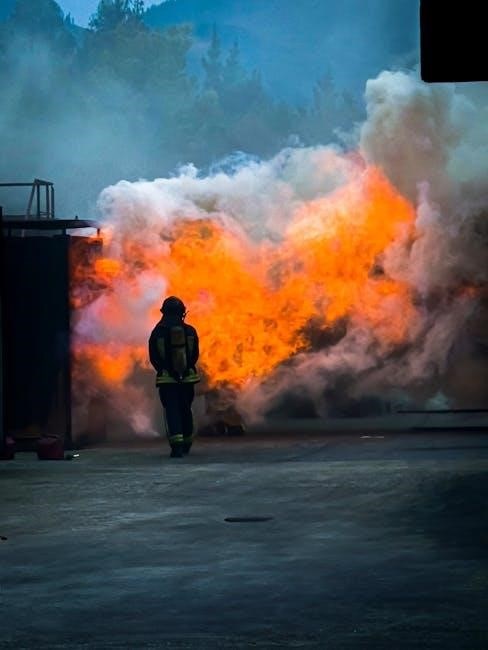nfpa 25 fire pump testing pdf
Overview of NFPA 25
NFPA 25 provides essential guidelines for the inspection, testing, and maintenance of water-based fire protection systems, ensuring fire pumps operate effectively during emergencies. Compliance is critical for fire safety.
NFPA 25, the Standard for the Inspection, Testing, and Maintenance of Water-Based Fire Protection Systems, plays a pivotal role in fire safety. Established in 1992, it ensures fire pumps and related systems are reliable and functional during emergencies. Compliance with NFPA 25 is critical for safeguarding lives and property. The standard provides detailed guidelines for inspecting, testing, and maintaining fire pumps, including diesel and electric motor-driven systems. Regular testing, such as no-flow (churn) and flow tests, ensures pumps deliver the required pressure and flow. Proper maintenance prevents system failures, which could lead to catastrophic consequences. NFPA 25 also emphasizes documentation and record-keeping to verify compliance. By adhering to these standards, fire safety systems remain operational, protecting people and assets effectively. This standard is essential for ensuring water-based fire protection systems function as intended in emergency situations.

Fire Pump Testing Requirements
NFPA 25 mandates fire pump testing, including daily, weekly, monthly, and annual inspections. Tests include no-flow (churn) and flow tests to ensure pumps meet performance criteria effectively;
2.1 Frequency of Fire Pump Tests (Daily, Weekly, Monthly, Annually)
NFPA 25 specifies fire pump testing frequencies to ensure reliability. Daily checks include verifying pump operation and controller status. Weekly tests involve casing relief valves and pressure relief valves. Monthly inspections cover suction and discharge valves, while annual tests include full-flow and no-flow (churn) tests. Additionally, semi-annual diesel fuel testing and annual electronic control module (ECM) inspections are required. These frequencies ensure compliance with safety standards and maintain fire pump performance. NFPA 25’s structured schedule helps prevent failures during emergencies by identifying issues early. Regular testing also aligns with fire safety regulations, ensuring fire pumps meet flow and pressure requirements. Adhering to these schedules is critical for reliable fire protection systems.
2.2 Types of Tests: No-Flow (Churn) Test vs. Flow Test
NFPA 25 distinguishes between two primary types of fire pump tests: the no-flow (churn) test and the flow test. The no-flow test, conducted weekly or monthly depending on the pump type, measures the pump’s ability to operate under suction pressure without discharging water. This test ensures the pump can handle suction conditions and maintain prime. In contrast, the flow test involves discharging water to verify the pump’s performance, including flow rate and pressure. It is typically performed annually and requires a flow of water to measure the pump’s capacity. Both tests are critical for ensuring fire pumps function correctly during emergencies. NFPA 25 specifies these tests to validate pump reliability and performance under varying conditions, ensuring fire safety systems are always operational.

Inspection and Maintenance of Fire Pumps
Regular inspection and maintenance of fire pumps ensure optimal performance. This includes checking fuel levels, battery condition, and mechanical components to comply with NFPA 25 standards.
3.1 Diesel Engine-Driven Fire Pump Maintenance
Diesel engine-driven fire pumps require regular maintenance to ensure reliability. Key tasks include checking fuel levels, oil condition, coolant levels, and battery charge. Annual testing of diesel fuel quality and electronic control module (ECM) performance is mandatory. Additionally, weekly no-flow (churn) tests must be conducted to verify pump operation. NFPA 25 specifies that these pumps must be inspected and tested according to a predefined schedule. Proper maintenance also involves replacing air and fuel filters annually and ensuring all electrical connections are secure. Following manufacturer recommendations is crucial for longevity and performance. Documentation of all maintenance activities is required to ensure compliance with NFPA standards and to track the pump’s operational history.
3.2 Electric Motor-Driven Fire Pump Maintenance
Electric motor-driven fire pumps require consistent maintenance to ensure optimal performance. Weekly inspections should include checking the voltage, which must be within 5% of the rated voltage, and verifying the fire pump controller’s calibration to 3%. Annual testing of the electronic control module (ECM) is essential to ensure proper operation. Additionally, monthly no-flow (churn) tests are necessary to confirm the pump’s readiness. Regular lubrication of motor bearings and monitoring for overheating are critical. NFPA 25 also mandates checking electrical connections for tightness and integrity. Proper documentation of all maintenance activities is required to maintain compliance and track the pump’s performance history. Adhering to these guidelines ensures the pump operates reliably during emergencies.

Acceptance Criteria for Fire Pump Tests
Fire pump tests are acceptable if the pump meets flow and pressure requirements, voltage is within 5% of rated voltage, and the controller is calibrated to 3% accuracy.
4.1 Conditions for Acceptable Fire Pump Performance
Fire pumps must meet specific performance criteria during testing to ensure reliability. The pump must deliver the required flow rate and pressure as specified in the system design. Additionally, the voltage must remain within 5% of the rated voltage, and the controller must be calibrated to ensure accurate operation. The fire pump controller should also be factory-calibrated and adjusted to 3% precision. Proper testing ensures the pump operates within acceptable parameters, guaranteeing effective fire suppression capabilities. These conditions are critical to maintaining fire safety standards and ensuring the system functions as intended during emergencies.
Documentation and Record-Keeping
Accurate documentation of fire pump tests, including flow rates, pressures, and maintenance activities, is essential; Records must be retained for review, ensuring compliance and system reliability over time;
5.1 How to Properly Document Fire Pump Test Results
Proper documentation of fire pump test results involves recording key details such as flow rates, pressures, and any anomalies observed during testing. Use standardized forms to ensure consistency and clarity. Include the date, time, and personnel involved in the test. Maintain records in accordance with NFPA 25 guidelines, which may specify retention periods. Digital documentation is recommended for better organization and accessibility. Ensure compliance with legal requirements for audits or inspections. Train personnel to accurately document results, noting any issues for follow-up. Clear and comprehensive records are essential for system reliability and accountability.
Adhere to NFPA 25 guidelines, ensure regular training, and maintain detailed records. Use checklists for inspections and address issues promptly to ensure fire pump reliability and safety standards.

Best Practices for Compliance
6.1 Tips for Adhering to NFPA 25 Standards
To ensure compliance with NFPA 25, develop a structured schedule for fire pump inspections, tests, and maintenance. Regularly review NFPA 25 guidelines and stay updated on any revisions. Train personnel on proper testing procedures, such as no-flow and flow tests, and ensure they understand the importance of documentation. Maintain detailed records of all tests and inspections, as these are crucial for audits and compliance verification. Additionally, incorporate checklists tailored to NFPA 25 requirements to streamline the process and minimize oversight. Address any issues promptly to prevent system failures. By following these practices, fire pumps will remain reliable, ensuring optimal fire protection and safety.